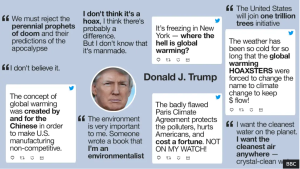Misinformation: The language of (unintentional) manipulation
12 Examples and Case-Studies in Misinformation
Example 1
Example 2
Misinformation is like a virus in that it spreads rapidly as more and more people interact with it. With that being said, a great example of misinformation can be understood when examining the claim that former US President Donald Trump encouraged his fellow American citizens to drink bleach in an effort to combat the spreading of COVID-19. Once the remarks from incumbent President Joe Biden surfaced, media outlets and social media users began claiming that Trump had implored everyone to drink bleach to kill COVID. But is this claim true?
A quick Google search revealed that it was indeed…false.
As reported by Austin-American Statesman, “Trump did not specifically recommend ingesting disinfectants, but he did express interest in exploring whether disinfectants could be applied to the site of a coronavirus infection inside the body, such as the lungs” (Calefati, 2020). Yet the sheer absurdity of this claim was the very reason it spread so quickly. Those, like myself, who initially believed and subsequently talked about the claim with others did not do so out of distaste for former President Trump, but because the claim itself was so wildly audacious. In telling other members of the public sphere that the claim was uttered, I myself contributed to the spread of misinformation, as I truly believed he did say that.
While President Biden spread disinformation by airing this claim (as it was likely intentional and had mal intent), audience members who echoed the words were spreaders of misinformation (as there was no ill intent).
References
Calefati, J. (2020, July 13). Fact-check: Did Trump tell people to drink bleach to kill the
coronavirus?. Austin American-Statesman. https://www.statesman.com/story/news/politics/elections/2020/07/13/fact-check-did-
trump-tell-people-to-drink-bleach-to-kill-coronavirus/113754708/
Example-3
Trump’s Climate Contradictions: Fueling Misinformation and Confusion

Trump has repeatedly called climate change a hoax by scientists and environmentalists, generally siding with skeptics who reject the scientific consensus. His constituency is skeptical and denialist due to his administration’s rollback of environmental regulations and withdrawal from international agreements like the Paris Climate Accord. Trump has occasionally expressed concern about environmental issues and supported conservation projects like planting one trillion trees. These gestures have been eclipsed by his climate science denials and pro-fossil fuel policies.Trump’s messaging inconsistency feeds misinformation and confusion among his fans. They may not know where Trump stands on climate change, causing confusion and a lack of direction. Interest groups and individuals who downplay climate change can exploit it. Since climate change threatens global ecosystems, economy, and public health, this misconception has serious ramifications. Trump’s contradictory messaging weakens efforts to address this serious issue and progress toward meaningful solutions by generating doubt and confusion.
Certainly there is evidence of increasing extremes in some parts of the world. Although these increases could simply be a result of natural climate variability, they are also consistent with many of the changes expected as a result of greenhouse warming. (Francis et al., 1998) This is not the best move for a politician who wants to win U.S. elections in 2024.
Francis, David, and Henry Hengeveld. Extreme weather and climate change. Ontario: Environment Canada, 1998.
VB
Example-4
TikTok Satire as Misinformation: A man’s satirical response to a TikTok video sparks the spread of misinformation
TikTok has become a source of information for many users around the world, but much of that information, consists of misinformation. There are many common misinformation examples that can be examines is the media, but one interesting aspect is satire. One author goes on to say that TikTok “is currently a pit of misinformation with the potential to cause harm to the user” (O’Sullivan, et al., 2022). One example of satire as misinformation is a recent video circulating the internet that had a lot of viewers misinformed…
This TikTok involves an individual, Alexandre, “duetting” an original video from a podcast describing an employee not wanting to show up to work early. As it turns out, the podcaster is reading off of a situation that a viewer sent in and the video of the man that “duetted” is satire.
Alexandre, who posted this TikTok. assumed that most would understand it as satire, which is why it can be seen as misinformation. Many comments on the post agreed with him and began to bash the podcast and the girl who was telling the story. Alexandre even states that “he was surprised to learn that people were taking his video so seriously, and he hopes that it won’t harm Natalie in her career” (Buzzfeed, 2024).
This entire situation is proof that many videos can be misleading. Although Alexandre did not purposely try to mislead so many people, the affects of his satire had negatives affects on the podcaster, Natalie, and showed the dangers of misinformation. [BR]
References
-
↵@trekfit #stitch with @Demoted huhhhhh?#corporatelife #gymrat #worklifebalance
♬ original sound - Alexandre Evidente

Feedback/Errata